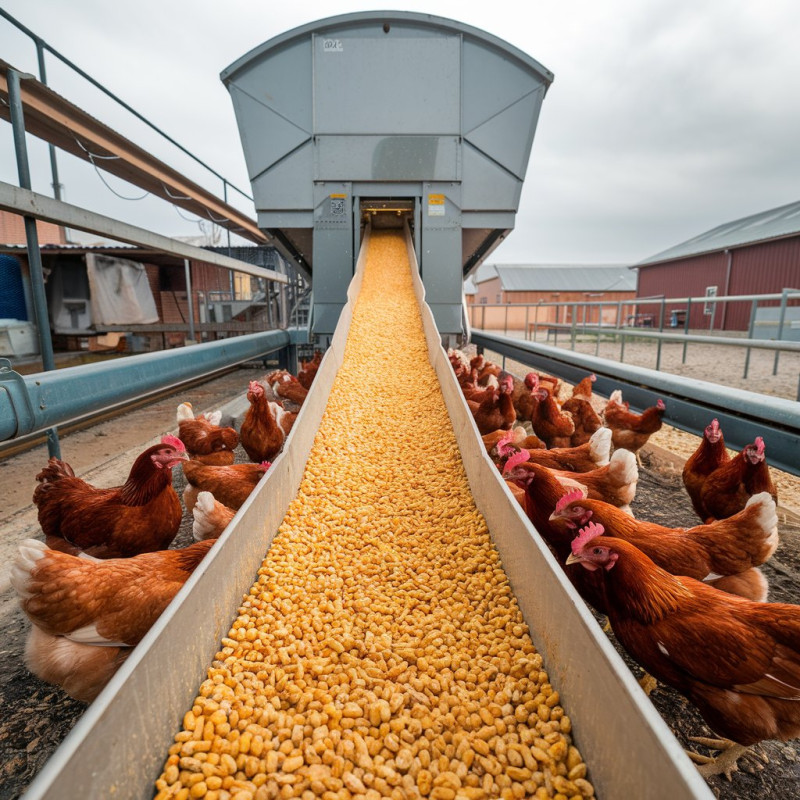Automated Poultry Feeders: Why They're a Game Changer for Poultry Farms
Date : 2024-12-28
Introduction: In the fast-paced world of poultry farming, optimizing operations and ensuring the well-being of your flock is crucial. One of the most significant advancements in poultry farming technology is the introduction of automated poultry feeders. These feeders have revolutionized how poultry farmers manage feed distribution, offering multiple benefits such as improved efficiency, reduced labor costs, and healthier chickens. In this blog, we will explore why automated poultry feeders are a game changer for poultry farms, and how they can transform your farming operation.
What Are Automated Poultry Feeders?
Automated poultry feeders are systems designed to distribute feed to your poultry at regular intervals without the need for manual intervention. They are typically connected to a central feed hopper or silo, and the system dispenses the feed into individual feeders or feeding trays as needed. These feeders can be programmed to release feed based on a set schedule or activated by sensors that detect when chickens are ready to eat.
Why Automated Poultry Feeders Are Essential for Modern Poultry Farms
1. Reduced Labor Costs
Best For: Large-scale poultry farms with a significant workforce.
Description: One of the biggest advantages of automated poultry feeders is the reduction in labor costs. Manual feeding systems require farm workers to distribute feed multiple times a day, which can be time-consuming and labor-intensive. Automated feeders do this job efficiently, freeing up your workers to focus on other important tasks, such as managing flock health or maintaining farm equipment.
Benefits:
Saves time and labor, especially in large operations.
Reduces the need for staff to physically distribute feed.
Lowers operational costs in the long run.
Image Prompt: "A poultry farm worker overseeing automated poultry feeders dispensing food to chickens."
2. Consistent Feed Distribution
Best For: Maintaining uniform nutrition across a flock.
Description: Automated feeders ensure that feed is consistently distributed across the flock, ensuring that all chickens receive the right amount of nutrition. Unlike manual feeding, where there may be variations in the amount of feed dispensed, automated systems deliver a uniform amount, reducing the risk of overfeeding or underfeeding.
Benefits:
Provides consistent feed delivery to all chickens.
Helps maintain a balanced and healthy diet for your poultry.
Ensures all chickens are well-fed and grow optimally.
Image Prompt: "Automated poultry feeders distributing feed evenly across multiple sections of a poultry barn."
3. Improved Feed Efficiency
Best For: Farms looking to optimize feed use and minimize waste.
Description: Feed waste is a common problem in traditional poultry farming, especially when chickens knock over or spill their feed. Automated poultry feeders are designed to minimize feed waste by dispensing only the required amount of feed, which not only ensures that chickens get the nutrition they need but also saves you money on feed.
Benefits:
Minimizes feed waste by providing just the right amount of feed.
Helps optimize feed costs, especially on large farms.
Reduces the amount of feed that gets spilled or contaminated.
Image Prompt: "Close-up of automated poultry feeders, distributing just the right amount of feed to the chickens."
4. Enhanced Farm Efficiency
Best For: Farms that want to streamline daily operations.
Description: The automation of feed distribution allows for streamlined operations on the farm. With automatic scheduling and feed monitoring, farmers can avoid the constant manual effort of feeding and ensure that their chickens always have access to fresh, nutritious food. This increases overall farm efficiency, leading to smoother daily operations.
Benefits:
Streamlines the feeding process, increasing farm efficiency.
Reduces human error in feed distribution.
Allows farmers to focus on other critical aspects of farm management.
Image Prompt: "A poultry farm with automated feeders, efficiently distributing food while farm workers focus on other tasks."
5. Better Health and Growth for Poultry
Best For: Ensuring optimal health and growth of broilers and layers.
Description: Consistent and controlled feed distribution plays a key role in the health and growth of your poultry. Automated feeders ensure that chickens have continuous access to the right amount of feed, promoting healthy growth rates, boosting egg production for layers, and improving overall flock health.
Benefits:
Helps maintain healthy growth rates for broilers.
Boosts egg production in layers.
Reduces stress on the birds due to constant access to food.
Image Prompt: "Healthy chickens eating from automated feeders, demonstrating growth and productivity."
6. Reduced Risk of Disease
Best For: Ensuring better biosecurity and minimizing contamination.
Description: Automated feeders are designed to be more hygienic than traditional feeding systems. Since feed is dispensed directly into containers, there is less opportunity for contamination from feces or dirt. This also reduces the risk of feed being consumed by rodents or other pests, which can be a problem with open feeding systems.
Benefits:
Reduces contamination of feed, lowering the risk of disease.
Minimizes the spread of pathogens from one chicken to another.
Improves biosecurity on your farm.
Image Prompt: "A hygienic poultry farm with automated feeders that reduce contamination and keep feed clean."
How Automated Poultry Feeders Work
Automated poultry feeders are powered by electricity or, in some cases, solar energy, and are designed to be simple to install and operate. These systems are connected to a central feed supply, such as a silo, and can be programmed to release feed at specific times of day or based on the needs of the flock. Some systems are equipped with sensors that detect when chickens are hungry, ensuring that feed is only dispensed when necessary. Most automated feeders also have a fail-safe system to prevent the feed from being dispensed too quickly or in excess.